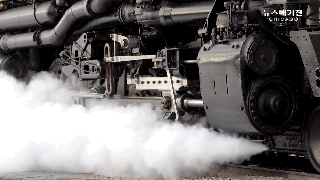





The HO layout has approximately 1,006 feet on each main line for a total of over 2,000 feet, or over 33 scale miles. Counting
the 168 foot hidden track on the OSL branch line and all the yards and sidings, there is a total of about 5,300 feet of HO track
on the layout.
The layout is built using a standalone mushroom design on two levels plus the third hidden layer level for the OSL. A
mushroom design allows foot traffic of both sides of all benches, so all welded steel framed free standing benches have two
levels (plus the hidden third layer). All of the upper level benches are accessed by operators and visitors from a riser built over
the concrete floor of the building. The lower level benches are reached from the concrete floor. You can see that the green
track of the lower level is accessible directly from the double front building doors, and the upper level must be reached by
walking around the next to the last bench on the right from those doors and up the two steps to get onto the riser. This
complicated arrangement uses a lot of space (no benches are up against walls), but it nearly doubles the bench space (and
room for track). The big advantage is that visitors and operators are always looking north across any bench, which makes the
tracks to the left appear to be going west, and those to the right seem to be going east. So it is a very natural feeling design,
especially if you have any familiarity with Wyoming and Utah. Another big advantage is realism; anyone on either level cannot
see anyone in an aisle except those to his left (west) or to his right (east), so it is like being on the tracks out on the prairie.
Operations According to History
Operations are all important to the Historical Society and to the layout, because it was built specifically as a “layout for
operations.” Operations in model railroading has a special meaning. It is not just running trains for the enjoyment of seeing
beautiful models in motion. It is running trains with a purpose, as if the operators were a full railroad industrial company trying
to make a profit by delivering freight and passengers for customers in a timely manner. This means each load or passenger on
each car has a specific unique destination as if the freight was requested to be moved there by customer freight agents, or
because each passenger bought tickets to go a certain place at a certain time. It definitely is not just running around the
Christmas tree, as can be seen by the extensive list of jobs in the third paragraph of this section.
The above italicized definition of operations is further complicated by the effort to make operations on the Wyoming Division HO
Layout prototypical, that is, as realistic as compared to the real UP in 1957 as possible. It could be argued that this makes
operations and the track plan simpler, because of the high fidelity to those of the Union Pacific.)
To be specific the HO layout operating system simulates that of the Union Pacific in 1957 which used Rule 251D with Written
Track Warrants as a traffic control method. On the east side of Sherman Hill this was supplemented by ABS (Automatic Block
Signals). (Aren’t you glad you asked?) What this boils down to is that to safely operate a train (the overriding reason for the
rule book), a Written Track Warrant is required as authority to move a train on a single track in a single direction. The “D” refers
to adopting the rule for double track, and written authority is still required but each track is for one designated direction (usually
double tracks use right hand running, but not always). The ABS supplements the written authority in that trains run in order
according to the signals unless a train is ordered by the Dispatcher to move to, or stay on, a siding or yard track to allow
another train (one that is superior) to pass.
This means the Dispatcher has to know at all times approximately where each train is, to make sure he can issue an order to be
given to a train crew to “go in the hole” (take a siding or stay in a yard) until a superior train can pass. That way the most
superior trains (passenger trains, followed by Pacific Fruit express [PFE] and stock [cattle, sheep, hogs], and priority freights,
and then the lowly drag freights and locals get to pass less superior trains. The Dispatcher keeps current on the positions of all
trains via a 16 phone system from the layout floor or riser to the Dispatcher (DS). Road Crews report to the DS via the phones
(or Tower Operators report for the road crews, as was actually done on real railroads). The Tower Operators or road crews
report train number (loco number), type of train (passenger, local, Manifest, Forwarder, or Special), direction of travel, and
location.
The passenger trains needing to be run to deliver people per a schedule is an obvious need. But how does a railroad,
especially one in 1957 without computers and few radios—certainly not in each cab—manage to move freight efficiently enough
to gain and keep customers? Real railroads used waybills generated by freight orders by customers to railroad freight agents,
who shuffle the papers to make the freight go the right place on time. The waybills were carried by the conductor in the
caboose. On the model, we simplify this process somewhat, but retain the flavor of prototypical freight orders and car
forwarding. Each model car has a car card or several cars may be considered to be a unit together as a block as if they were
one “car,” and that block will have a card. Either way the car or block cards specify the present location (“from”) and a
destination (“to”), and whether the car starts and ends as full or empty (MT)—similar to a waybill. The cards stay with the cars
(in a pocket on the front fascia of the bench) or with the road crew on their clipboard, a standard office clipboard (as in the
caboose). When a car (with its card) arrives at a destination, it is set out by the crew and new-to-the-train cars are picked up to
be taken with the train as it leaves. This way cars or loads or blocks of cars arrive at their final destinations from any originating
location on the layout.
Operating Sessions
So an operating session is a fast paced 3D real time “video game” with many players (up to 40), with passenger trains passing
all other trains if necessary while they wait for them to pass, other superior trains passing others, and passengers boarding or
stepping off the passenger trains at each depot along the route, and freight being picked up at any loading dock in any yard,
town, or country and other freight cars being set out anywhere, all under the control of the Dispatcher who gives orders to the
Tower Operators who pass them on to the Yardmasters and road crews, and the Classification Foremen and Hostlers take
directions from the yardmasters to make sure the setouts and pickups get done correctly, and the locomotives are changed
according to the grade ahead and the load being hauled. Oh, and the locomotives have to take on diesel fuel every half day or
so, but the steam engines need coal and water about every 50 miles! That is, whenever the Locomotive Card says to stop for
those commodities. And we try to do it like the real railroad did it in 1957 without radios or computers. Our limited paperwork is
real paper (cards). It is easy to see why it is such a fun and rewarding hobby, and how historically interesting it is, especially for
youngsters.
Youngsters and Ladies
Speaking of kids, there is no reason for us older modelers to lament the lack of youngsters in the hobby. See the article I wrote
for the AZ Division of the National Model Railroad Association (NMRA)
KIDS AND LADIES ON AND ABOUT THE WYOMING DIVISION
Or
Don’t Tell Me There Ain’t No Kids or Ladies in Model Railroading
It is reprinted in the “Articles” section.
Highlights of the HO Layout
•
Scale: HO
•
Prototype: Union Pacific, Wyoming Division (Cheyenne, WY to Ogden, UT, 485 miles)
•
Era: 1957
•
Design Style: Point to point double track from Cheyenne, Wyoming to Ogden, Utah
•
Main Line Length (measured): Track #1 and Track #2 each: approximately 1,006 feet (16.59 scale miles point to point
including 45 feet of main line in staging) (2,012 feet total)
o
Total Track: approximately 5,300 feet (including branches, yards and all staging)
o
Yard Track Lengths: 17 foot minimum all yards and
o
Branch lines: Coalmont Branch (junction Laramie); Reliance Branch continues as US Steel RR to Atlantic City
(junction Rock Springs); Oregon Short Line (OSL to “Portland, Oregon” separate staging; Park City Branch (junction
Echo, Utah)
•
Average Time to Complete Train run from Cheyenne to Ogden with average number of stops for occasional switching and
fuel stops and engine changes: 1 – 1 1/2 hour +
•
Layout Building inside area: 3,626 square feet (inside area of 50 x 75 foot outside dimension building)
•
Multi Level Construction: two main levels with a third “hidden level” for OSL route to “Portland” staging
•
Unique Construction Techniques:
o
Welded steel frame from 1 ½” square steel tube supports all levels of benches
o
Bench sides and tops ½” thick plywood screwed with steel self-tapping screws to make vertical and horizontal sheer
panels. Lightweight benches can be walked on.
o
¼” thick flooring underlayment cork on spline roadbed
o
Cork bevel cut and split with custom vacuum hold down table
o
10 ga. DCC main power bus, 14 ga sub buses, 18 ga feeders spotwelded, not soldered, to nickel silver rails.
o
Wiring trays built into each bench at front of benches at waist height with hinged doors. All screw connected DCC
components in those waist high aisle facing trays.
o
Upper level riser doubles as conduit under “floor,” so little conduit needed embedded in concrete floor. Access
through riser hatcher at key points.
o
Aisle widths 41” and 54”
•
Staging on Lower Level:
o
simulates Chicago, KC, St. Louis etc. east of Cheyenne
o
simulates LA and Oakland west of Ogden (Colton and Marysville for PFE loading)
o
a third “hidden level” for OSL route to “Portland” staging (187 feet, Granger, Wyoming to Portland)
•
Operations:
o
Built for Operations: (Monthly operating sessions plus special sessions—see link below to join Op Session
Groups.io Group)
▪
4 Main Yards each require YM, Classification Foreman, Hostler/Tower Operator (Hostlers choose locomotives
and helpers)
▪
2 Dispatchers (one for each level) (keep Train Sheet, Road crews OS via 8 phones on each level to DS)
o
Freight and Passenger trains, 1957 era (Late Steam Locomotives and Gas Turbines yielding to Diesels)
o
Long, heavy trains with huge locomotives and helpers(with individual operators for each loco for:
▪
Sherman Hill west (Cheyenne to Laramie, Wyoming) (2.10% grade), and,
▪
Wasatch Mountains east (Ogden, Utah to Evanston, Wyoming) (1.96% grade)
o
Most Trains are Transcontinental Trains: with some Head End switching and Block switching:
▪
West bound blocks switched at Green River, Wyoming for either OSL to Portland (staging) or west through
Ogden to California (staging)
▪
East bound blocks switched at Laramie for either east through Cheyenne (Staging) or south bypassing
Cheyenne to Denver (staging)
▪
Many locals (coal drags with coal agent work east and west, Downtown Ogden, Park City Branch, Cheyenne
East and West Locals, Ogden Local, Cheyenne to Green River, Ogden to Green River
o
Operating sessions typically have 36+ guest operators
•
Modeling Details: wide open spaces 50 to 121ft between towns and broad curves (42 to 53” radius), prairies, mountains
(Sherman Hill and Wasatch Mountains), towns, ranches, mines, 6 turntables, DCC operation with sound, all 11 Union
Pacific Tunnels between Cheyenne and Ogden including one abandoned tunnel
•
Construction Status (as of 4/15):
o
Bench work, Track and DCC System: Complete, runs very well
o
Phones: Complete with 16 phones on layout to 2 DS phones, 6 boosters, radio throttles
o
Operations: Regular Monthly Operating Sessions, 2nd Saturday of each month since October, 2013.
o
Invitational Meets: See “Annual Invitationals” under “Operating Sessions” tab.
o
Backdrops: Photo and painted backdrops in progress
o
Signals: ABS System Designed, Signals due to be delivered April 2015, to be installed
o
Terrain: Some in place with Bragdon Enterprises hard shell completed, to be completed as soon as signals wired
and tested, other terrain awaiting hard shell
o
Structures: Approximately ½ of main structures completed
o
Scenery: awaiting backdrops and signal completion
•
Physical Plant: Main 50 x 75 foot building and 30 x 36 foot shop completed, 20 x 30 foot addition for Crew Lounge
construction started March, 2015.
•
Details about the Layout: https://groups.yahoo.com/neo/groups/wyoming_division/info
•
Details about Operating on the Layout (requires approval and interest in operating on the layout):
https://groups.io/g/wyodivops
•
Photos: http://verrylvfosnightjr.slickpic.com/albums/WyomingDivisionHOOperationLayout/
•
Photos: Lorne Noyes also has taken good photos of our operating sessions at his SlickPic site
http://arizonalorne.slickpic.com/albums/WyomingDivisionHistoricalSocietyHOScaleModelRailroad/?squared




























